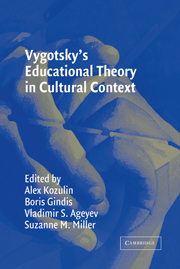Book contents
- Frontmatter
- Contents
- List of Contributors
- Series Foreword
- Introduction: Sociocultural Theory and Education: Students, Teachers, and Knowledge
- PART I CONCEPTS AND PARADIGMS
- PART II DEVELOPMENT AND LEARNING
- PART III SOCIOCULTURAL THEORY APPLICATION IN THE CLASSROOM
- PART IV DIVERSE LEARNERS AND CONTEXTS OF EDUCATION
- 16 Intrapersonal Communication and Internalization in the Second Language Classroom
- 17 Mediation in Cognitive Socialization
- 18 Cultural Modeling
- 19 The Relations of Learning and Student Social Class
- 20 Vygotsky in the Mirror of Cultural Interpretations
- Author Index
- Subject Index
- Titles in the series
- References
16 - Intrapersonal Communication and Internalization in the Second Language Classroom
Published online by Cambridge University Press: 05 June 2012
- Frontmatter
- Contents
- List of Contributors
- Series Foreword
- Introduction: Sociocultural Theory and Education: Students, Teachers, and Knowledge
- PART I CONCEPTS AND PARADIGMS
- PART II DEVELOPMENT AND LEARNING
- PART III SOCIOCULTURAL THEORY APPLICATION IN THE CLASSROOM
- PART IV DIVERSE LEARNERS AND CONTEXTS OF EDUCATION
- 16 Intrapersonal Communication and Internalization in the Second Language Classroom
- 17 Mediation in Cognitive Socialization
- 18 Cultural Modeling
- 19 The Relations of Learning and Student Social Class
- 20 Vygotsky in the Mirror of Cultural Interpretations
- Author Index
- Subject Index
- Titles in the series
- References
Summary
This chapter considers an aspect of sociocultural research that has not been fully explored with regard to second language learning – the process through which learners develop the repertoire of symbolic artifacts they use when engaging in communicative activities (verbal and visual) in the second language. I will argue that the key to this development resides in internalization, a process closely affiliated with private speech. Carroll (2001, pp. 16–17) points out that the process of acquisition is “not directly observable” and can only be inferred “on the basis of other observable events such as the utterances that learners produce, the interpretation they assign to utterances they hear or read, the time it takes to interpret an utterance, their judgements of the acceptability of utterances, etc.” The specific goal of this chapter is to argue that it is possible to observe, at least in part, the process of language learning through analysis of the intrapersonal communication (private speech) produced by learners in concrete objective circumstances of the language classroom.
Unlike most theories of language acquisition, in particular that espoused by Chomsky's innatist theory, the sociocultural perspective recognizes that humans are not completely at the mercy of their biology; rather it sees humans as agents who regulate their brains rather than the other way around.
- Type
- Chapter
- Information
- Vygotsky's Educational Theory in Cultural Context , pp. 349 - 370Publisher: Cambridge University PressPrint publication year: 2003
References
- 28
- Cited by

